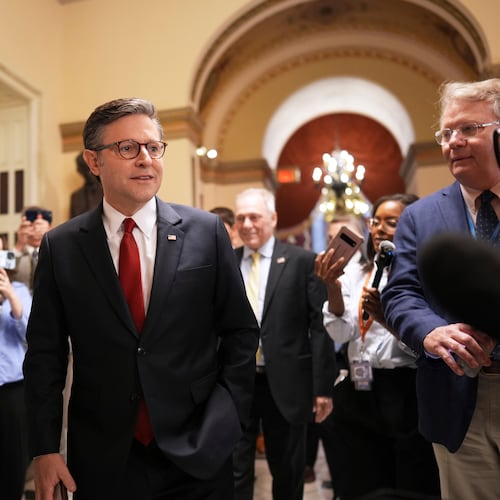While talk of a recession in 2023 has ramped up, Democratic gubernatorial nominee Stacey Abrams is proposing $800 million a year in new spending on pay raises, health care expansion and other programs.
Abrams says Georgia needs the new spending to meet its obligations to, for instance, make sure schoolchildren have top teachers in the classroom. Gov. Brian Kemp and Republicans look at the economic clouds ahead and the expenses the state already faces from a growing population and say what she wants is too costly.
“She’s smart enough to know that isn’t going to work,” said state House Appropriations Chairman Terry England, R-Auburn.
But Abrams said last week that her spending plan to raise teacher and state law enforcement pay, to add Georgians to the public health care system, to spur the growth of small businesses, is affordable, in part because of the giant tax surplus the state will likely report this month. Some of that surplus would pay for the new spending she proposes if she knocks off Kemp in November.
“The question is not ’Do we have the resources?’ The question is ‘What are we going to do with the resources we have?’ ” said Abrams, who narrowly lost the governor’s race to Kemp in 2018.
The other question is, will that surplus money be available to spend?
When the state ran a record surplus last year, Kemp pushed the General Assembly to let him refund $1.1 billion of it to Georgians. As a Republican facing reelection, he is almost certain to call for a big chunk of this latest surplus to be returned to taxpayers as well.
“Georgia voters going into the primary got a refund from Brian Kemp, and it’s not crazy to think they might get another one courtesy of the governor this fall, too,” said Brian Robinson, a Republican political consultant and former staffer with Gov. Nathan Deal. “Not a bad move when working Georgians are struggling to pay for gas and groceries — and blaming Abrams’ party for it.”
Democrat sees her proposals as doable
In some ways, Kemp has had a dream six months for an incumbent running for reelection. In part because federal spending to mitigate the impact of the COVID-19 pandemic propped up finances, Kemp had more money to spend this year than any governor in Georgia’s history.
Besides the refund, he was able to get raises and bonuses for state employees and teachers, back a big cut in the income tax rate, and increase spending in areas ranging from mental health services to colleges and road programs. He has been able to afford to temporarily suspend the state gas tax to ease the burden of rising fuel prices.
Kemp and his campaign have played up his use of the largesse and the tax cuts, and he thumped ex-U.S. Sen. David Perdue — former President Donald Trump’s candidate — in the GOP primary in May. Now, before the general election, he’ll be able to brag about another record state surplus and likely promise to give billions of dollars back to Georgia voters.
When Abrams, a former Georgia House minority leader, first began rolling out her proposals this spring, they were quickly met by skepticism from Republicans who said she was trying to one-up the governor with ideas the state couldn’t afford.
Abrams has proposed raising the minimum salary for Georgia public school teachers to $50,000 a year as part of a four-year plan to hike the pay of K-12 educators by $11,000. That’s more than twice as much as Kemp raised pay during the past four years.
Abrams estimates her plan would increase spending on teacher salaries by $400 million annually during each of the next four years. By the end of the four years, the teacher payroll would be $1.6 billion higher.
She has called for salary increases for state corrections and law enforcement officers, increasing spending an additional $77.5 million each of the next two years, and for providing $25 million more annually in grants to local law enforcement agencies to help finance pay hikes and defray housing costs for staffers.
She has long been a proponent of expanding Medicaid — the health care program for the poor and disabled — to add 500,000 Georgians to the rolls. She estimated the cost at $297 million to $350 million annually over the next five years.
Her campaign website includes several other proposals.
On the revenue side, she’s called for the gas tax — which pays for road and bridge projects — to be suspended through the end of the year. That’s a cut of about a $170 million a month in revenue.
She’d also implement the income tax rate cut that lawmakers approved this year. While it is being phased in over several years, it will eventually save Georgians — and cost the state — about $1 billion a year.
Abrams, a tax attorney who served on budget and tax committees in the House and helped stop a tax hike on middle-income Georgians a decade ago, has seen the criticism of her proposals. But she calls them not only realistic, but necessary. The pay raise for educators, for instance, is needed to help stem the exodus of teachers and recruit new ones to help children who have fallen behind in the classroom, she said.
“Georgia is facing a teacher shortage,” she said. “If we do not do this, we will not have the teachers we need to meet our fundamental obligation as a state. This is not pie-in-the-sky, this is not nice-to-do, this is necessary.”
Medicaid expansion — most of which would be paid for by the federal government — would reduce the number of Georgians without health insurance and help financially strapped rural hospitals, she has said. Republicans have long opposed it and other elements of the Affordable Care Act that then-President Barack Obama signed into law more than a decade ago, saying it costs too much.
Abrams’ plan also includes the $900 million that the state typically adds each year to its budget to accommodate for annual growth in K-12, college and Medicaid enrollment, and other costs.
Conservative estimates
Alan Essig, a former state budget analyst and longtime fiscal policy expert, worked with Abrams on her budget plan. He used revenue and spending estimates from Kemp’s budget office and said he factored in the possibility that tax collections would drop next fiscal year due to a downturn in the economy.
“My instructions from Leader Abrams was to be as realistic and conservative as possible,” Essig said.
The most controversial element of the plan may be to use up to $2.6 billion worth of surplus funds over the next four years to balance the books and pay for the new spending on teacher pay raises and other things.
Budget officials frown on using one-time windfalls — such as a surplus — to pay for continuing obligations — such as a raise that will permanently increase the state payroll. Kelly Farr, the governor’s budget director, said the state could lose its top bond rating — which keeps borrowing costs low — if it uses surplus for ongoing costs.
Essig said under Abrams’ plan, the surplus money would be used until normal tax collections rise high enough to pay for her programs.
Kyle Wingfield, president of the conservative Georgia Public Policy Foundation, said with the national economy unstable, it’s not a good time to look at new government spending.
Because of inflation, it is going to cost the government more to do what it does — from building roads and bridges to transporting schoolchildren and patrolling highways. If the stock market continues to struggle, the state may have to put more into massive pension funds that rely on investment gains, he said.
The big surpluses of the past few years — fueled by federal COVID-19 spending — are not the norm, he added.
“This seems like more of a wait-and-see period,” Wingfield said. “We’re in a period of volatility, and that’s a tough time to take on new commitments.”
But Danny Kanso, senior policy analyst for the left-leaning Georgia Budget and Policy Institute, said the state is currently in such a strong financial position now in part because it underfunded areas of importance, like education, and that it has an opportunity to make up for that past austerity.
“In weighing the multitude of proposals to direct surplus funds and higher-than-expected revenue collections, state leaders have both a clear opportunity and an obligation to do more with the unprecedented level of resources available to address the long-standing needs of Georgians,” he said.
About the Author
Keep Reading
The Latest
Featured




